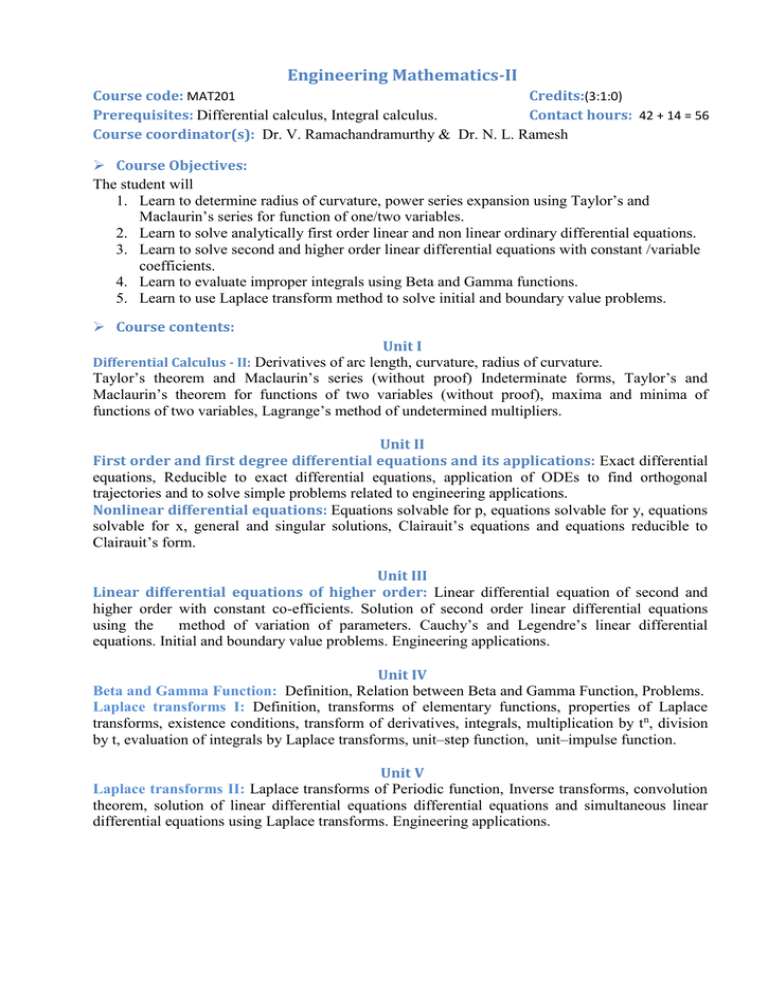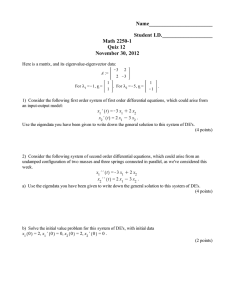Engineering Mathematics-II
advertisement

Engineering Mathematics-II Course code: MAT201 Credits:(3:1:0) Prerequisites: Differential calculus, Integral calculus. Contact hours: 42 + 14 = 56 Course coordinator(s): Dr. V. Ramachandramurthy & Dr. N. L. Ramesh Course Objectives: The student will 1. Learn to determine radius of curvature, power series expansion using Taylor’s and Maclaurin’s series for function of one/two variables. 2. Learn to solve analytically first order linear and non linear ordinary differential equations. 3. Learn to solve second and higher order linear differential equations with constant /variable coefficients. 4. Learn to evaluate improper integrals using Beta and Gamma functions. 5. Learn to use Laplace transform method to solve initial and boundary value problems. Course contents: Unit I Differential Calculus - II: Derivatives of arc length, curvature, radius of curvature. Taylor’s theorem and Maclaurin’s series (without proof) Indeterminate forms, Taylor’s and Maclaurin’s theorem for functions of two variables (without proof), maxima and minima of functions of two variables, Lagrange’s method of undetermined multipliers. Unit II First order and first degree differential equations and its applications: Exact differential equations, Reducible to exact differential equations, application of ODEs to find orthogonal trajectories and to solve simple problems related to engineering applications. Nonlinear differential equations: Equations solvable for p, equations solvable for y, equations solvable for x, general and singular solutions, Clairauit’s equations and equations reducible to Clairauit’s form. Unit III Linear differential equations of higher order: Linear differential equation of second and higher order with constant co-efficients. Solution of second order linear differential equations using the method of variation of parameters. Cauchy’s and Legendre’s linear differential equations. Initial and boundary value problems. Engineering applications. Unit IV Beta and Gamma Function: Definition, Relation between Beta and Gamma Function, Problems. Laplace transforms I: Definition, transforms of elementary functions, properties of Laplace transforms, existence conditions, transform of derivatives, integrals, multiplication by t n, division by t, evaluation of integrals by Laplace transforms, unit–step function, unit–impulse function. Unit V Laplace transforms II: Laplace transforms of Periodic function, Inverse transforms, convolution theorem, solution of linear differential equations differential equations and simultaneous linear differential equations using Laplace transforms. Engineering applications. Text Books: 1. Erwin Kreyszig –Advanced Engineering Mathematics, Wiley publication, 10th edition, 2015. 2. B.S. Grewal – Higher Engineering Mathematics, Khanna Publishers, 43rd edition, 2014. Reference Books: 1. Peter V. O’ Neil – Advanced Engineering Mathematics, Thomson Brooks/Cole, 7th edition, 2011. 2. Glyn James – Advanced Modern Engineering Mathematics, Pearson Education, 4th edition, 2010. Course Delivery: The Course will be delivered through lectures, class room interaction and exercises. Course Assessment and Evaluation: What To whom Direct Assessment Methods Internal assessment tests CIE Assignments Indirect Assessment Methods Max Marks Evidence collected Contributing to course outcomes 30 Blue books 1 to 5 Twice 10(5+5) Once 05 Quiz test 2 Once 05 Standard examination End of Course 100 Quiz test 1 SEE When/Where (Frequency in the course) Thrice (Average of the best two will be computed) Students Middle of the course Student feedback Students End of Course survey Assignment reports Quiz answers Quiz answers Answer scripts 1,2,3,4 1,2,3,4 1 to 5 Feedback forms 1 to 5, delivery of the course Questionnaire 1 to 5, Effectiveness of delivery of instructions and assessment methods End of course 1,2,3,4 Questions for CIE and SEE will be designed to evaluate the various educational components (Bloom’s taxonomy) such as: Remembering and Understanding the course contents (Weightage: 25%) Applying the knowledge acquired from the course (Weightage: 35%) Analyzing and evaluating the related information (Weightage: 40%) Course Outcomes The students will be able to, 1. Determine the radius of curvature, find extreme values of a given function. 2. Express a function as infinite series using Taylor’s and Maclaurin’s theorems. 3. Solve analytically first order linear and non-linear ordinary differential equations. 4. Solve second order linear differential equations with constant/variable coefficients 5. Solve initial and boundary value problems using Laplace transform method.



